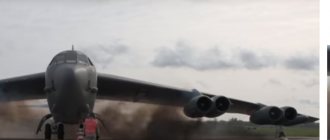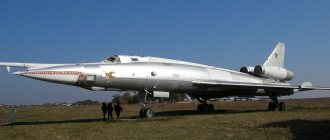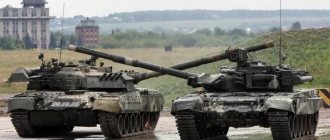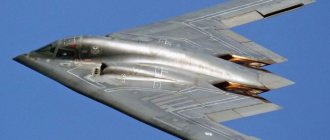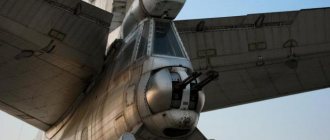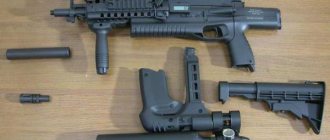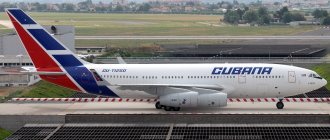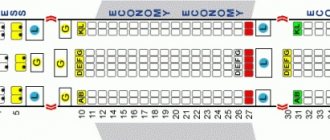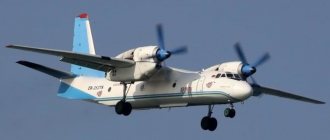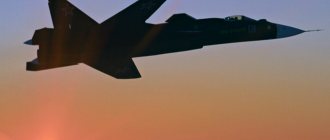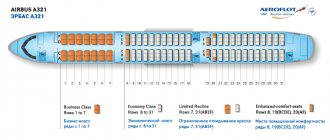The beginning of the way
The SR-71 has a solid pedigree. Its main “parent” is the outstanding designer Clarence Johnson, who largely determined the development of US military aviation at the end of the twentieth century. And the “homeland” of the “Blackbird” can rightfully be considered the workshops of the famous “Skunk Works” - one of the leading divisions of the Lockheed corporation.
Clarence Johnson and his U-2 and SR-71
The predecessor and prototype of the SR-71 was the A-12 high-altitude reconnaissance aircraft, also created by C. Jones. For the beginning of the 60s, the A-12 showed truly “exorbitant” results in speed - 3300 km/h and flight altitude - about 29 km. According to Johnson and his colleagues, this should have been enough to carry out unpunished reconnaissance flights over the territory of the USSR and Cuba.
A-12 reconnaissance aircraft
But the grandiose plans of the CIA, which was in charge of A-12, were never destined to come true. On May 1, 1960, its “big brother” - the U-2 spy plane, piloted by Francis Powers, was turned into a pile of debris near Sverdlovsk by an S-75 anti-aircraft missile. It became clear that the time of unpunished flights over the USSR was irrevocably over.
History of appearance
Aircraft accident statistics began to shine with the beginning of the era of air flights. The more aircraft took off, the more casualties and incidents occurred. Increasing aviation safety is without which the further development of flights would be impossible. Flight recorders have become good assistants in this matter.
The predecessors of the instruments consisted of a clock mechanism with a paper feed. On a long strip of paper, a pen and ink automatically recorded instrument readings. The convenience was that the recording was made constantly, and the pilots could not be distracted by this activity. This method, of course, was not reliable, and was only useful when assessing the condition of the aircraft after a successful landing. The black box with the inkwell could not survive a plane crash.
The authors of the first serious on-board recording device are François Husseno and Paul Baudouin. In 1939, they presented the first model of a BUR, which worked on the principle of a light-beam oscilloscope. The safety of civil and military air travel has improved significantly since 1967, when flight recorders were made mandatory on all aircraft.
The flight recorder was constantly changing during its existence; different methods of recording flight data were used. The advanced achievements of science of each period were reflected in the design of the BUR. At different times, magnetic tapes and steel wire, punched cards and other technical devices were used to record flight parameters. A modern recorder consists of a flash card and microcircuits that record the technical state of systems, crew actions and overboard parameters.
Ahead of its time
However, work continued.
We must pay tribute to K. Johnson, who stood out among his colleagues with an incredible flair and desire for everything new, without which progress in aviation is unthinkable. Until now, the appearance of the SR-71 “Blackbird” is striking in its unusualness. This machine was far ahead of its time, not only due to its enormous speed, but above all to the unique technological and engineering ideas embodied in it. The SR-71 featured a tailless design. In its swift flight to the target, the Blackbird relied on trapezoidal swept wings. It lacked traditional stabilizers and horizontal tail surfaces. Their functions were assigned to all-moving keels, slightly tilted inward by 15 degrees.
The three-post chassis also had some features. So the front strut was retracted against the movement, and the rest were retracted into the wing and fuselage towards the longitudinal axis of the vehicle. Here, stealth technology was first used, thanks to a special dark blue paint, which simultaneously protected the aircraft body from overheating, camouflaged it and made it unnoticeable to ground-based radars.
The list of stealth technologies can be supplemented with a special radio-absorbing coating, a special shape of the fuselage and the addition of cesium to the fuel, which reduces the exhaust temperature.
| Performance characteristics of the Lockheed SR-71 | Index |
| Range, m | 16,94 |
| Length, m | 32,74 |
| Height, m | 5,64 |
| Wing area, m2 | 141,1 |
| Maximum take-off weight, t | 78 |
| Empty weight, t | 30,6 |
| Fuel capacity, l | 46180 |
| Speed at an altitude of 24 km, km/h | 3300 |
| Height ceiling, km | 25,9 |
| Rate of climb, m/s | 60 |
| Tactical range, km | 2000 |
| Flight range without refueling, km | 5230 |
| Flight duration without refueling | 1h 30 min |
| Run, m | 2745 |
| Mileage, m | 1830 |
| Crew, people | 2 |
The SR-71 developed enormous speed thanks to two ramjet engines manufactured by Pratt & Whitney with a power of 10,603 hp each. every. In afterburner, their thrust increased to almost 14.5 thousand hp. For them, special JP-7 fuel and the most advanced on-board and reconnaissance equipment at that time were developed. The crew consisted of two people.
Scout SR-71 Blackbird - video
The two-seat SR-71A was made primarily of titanium to increase the strength of the airframe's structure under kinetic heating conditions (at speeds exceeding Mach 3 (for example, some structural elements heat up to 3000 degrees). Because aerodynamic drag increases significantly with increasing speed, the thinnest possible fuselage and delta wing were adopted, along with large "swells" in the forward part of the fuselage, creating lift and preventing the aircraft from being pulled into a dive as speed increased.Two constantly operating Pratt-Whitney J58 turbojet engines were the main part of the combined power plant These engines provided full thrust at low speeds, but at Mach 3 they provided only 18% of the thrust, with the remainder provided by the ramjet engine.
Ordered to replace the Lockheed U-2 strategic high-altitude reconnaissance aircraft, the SR-71A Blackbird first flew on December 22, 1964. In January 1966, it entered service as the first aircraft of the United States Air Force. with a speed of 3 M. The aircraft was mass-produced in 1966-1967. It is believed that the production of these machines should have included a total of thirty-two two-seater aircraft, including two trainers. SR-71B and one SR-71 C, which differ from the original in the modified shape of the cockpit (raised rear seat) and the presence of false wings under the engine nacelles. The SR-71A aircraft has a tailless design with a wing that smoothly mates with the fuselage. The aircraft has a blue-black color, which gives its surface a high heat-emitting ability (0.93).
The SR-71A Blackbird is equipped with an automatic flight control system with a three-channel redundancy scheme, which consists of a three-axis stability improvement system, an autopilot and a Mach balancing system. The aircraft's equipment includes an astroinertial navigation system that provides automatic tracking of a selected star during the daytime , and an aerodynamic data computer.
The five main compartments of the forward fuselage house optical-electronic (GUNT) and radio-technical (COMINT) reconnaissance equipment, which includes: a laser system, short-focus panoramic aerial cameras with a focal length of 610 mm, a long-focus aerial camera for side perspective shooting of the LOROP type with a lens with focal length 1680 mm and resolution 76 cm at a range of 96 km. These means allow one flight to conduct reconnaissance of an area of 259,000 km2 from an altitude of 24,400 m. The aircraft is also equipped with an electronic warfare system with passive and active means. The SR-71 is crewed by a pilot (in the front seat) and a reconnaissance equipment operator, who can serve as a co-pilot, engineer or navigator if necessary.
By 1988, only 6 SR-71 aircraft remained operational, and in November 1989 they were taken out of service. The official decommissioning ceremony took place in January 1990, and the remaining aircraft were distributed as patrol aircraft to air bases. Two aircraft went to the Air Force Museum at Wright-Patterson Air Force Base and the Smithsonian Aeronautics Museum in Washington.
Due to its performance characteristics, the SR-71 aircraft received confirmation from the Fédération Aéronautique Internationale (FAI) for record flights from New York to Farnborough in September 1974 (in a fantastic time: 1 hour 55 minutes and 42 seconds) and (several days later) return flight London - Los Angeles (3 hours 47 minutes and 39 seconds). Finally, on March 6, 1990, the Smithsonian's SR-71 set another record, flying from Los Angeles, California, to Washington, DC in 64 minutes and 5 seconds at an average speed of 2,153 mph.
Surprise over the sudden retirement of the Blackbird has subsided as mentions of a new and as-yet undesignated high-speed aircraft that could be a successor to the SR-71 have grown. This "black" aircraft, a development and codenamed "Aurora", was seen flying at high supersonic speeds with a characteristic sound "wave" over Southern California. It is believed to be equipped with a radically new engine, which leaves a characteristic “long sausage”-shaped condensation trail at high altitudes and an easily recognizable sound.
Flaws
Refueling the SR-71
Overall, the car was a success, although it was not without its flaws. The SR-71 turned out to be quite heavy. Its maximum take-off weight exceeded 77 tons, and colossal efforts were required to lift such a colossus from the ground. A solution was found, although not entirely flawless. The plane was not fully refueled, only for 1.5 hours of flight, and the rest was picked up in the sky at an altitude of more than 7 thousand meters from the KS-135Q tanker aircraft.
Achievement list
The SR-71's combat achievements are quite modest: North Korea, Vietnam, where it was almost shot down by a Soviet missile, the Arab-Israeli conflict in October 1973, and provocative reconnaissance flights along the Soviet border in the Kola Peninsula area.
The Blackbird spent the last years of its service at NASA, where its unique characteristics were used to develop promising aviation technologies. The SR-71 set the absolute speed record back in 1976 – 3530 km/h.
In 1998, the SR-71 was retired from service. There were several reasons. The main one is the high accident rate. 12 of the 32 vehicles built were lost in accidents. The Blackbird was also very expensive for the US Air Force. Suffice it to say that their flights cost the American treasury over $1 billion.
